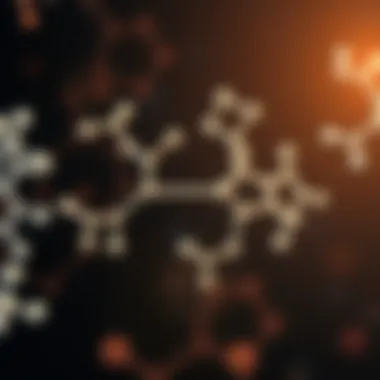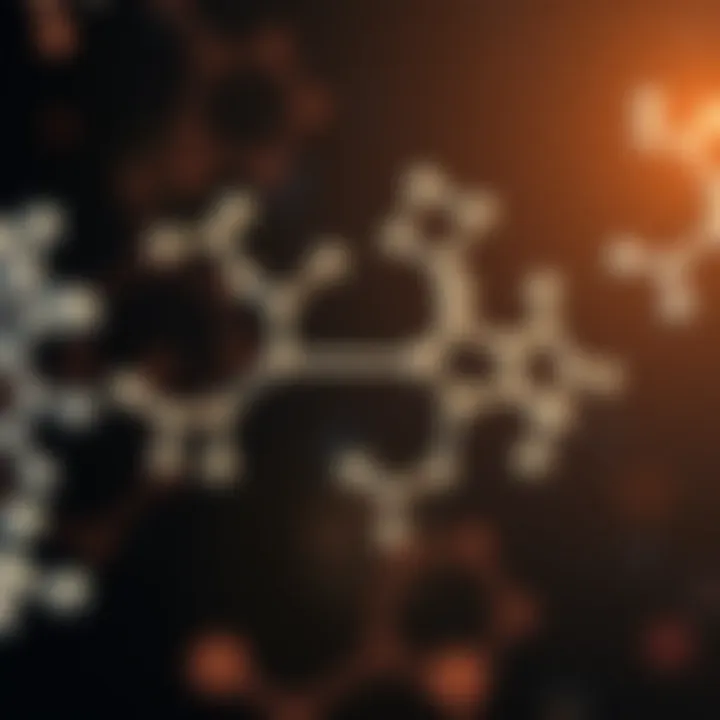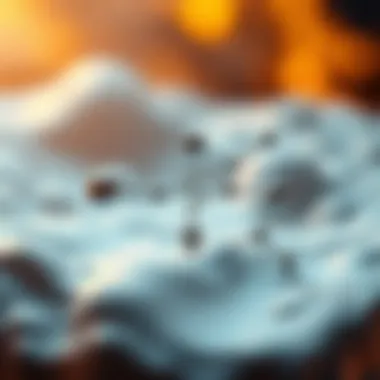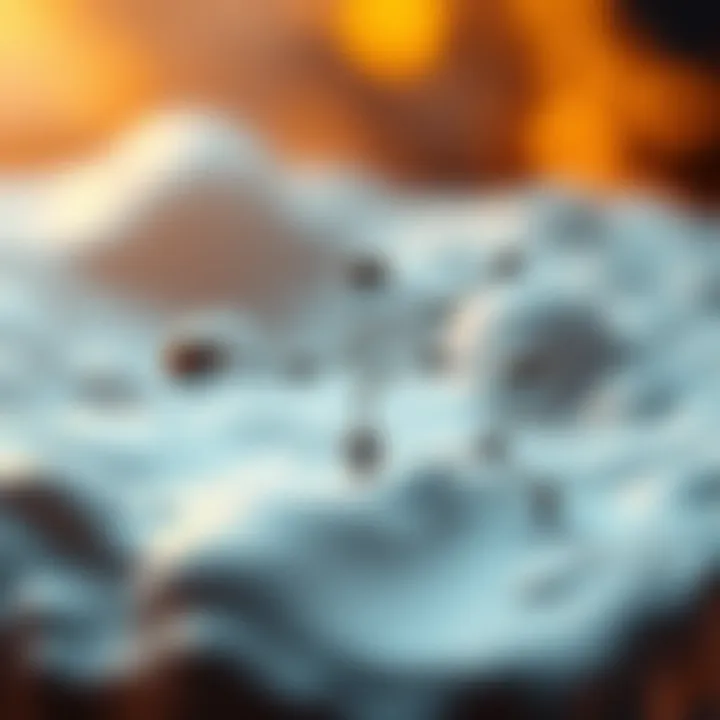Exploring Flat Molecules: Structure and Applications


Intro
The vast world of chemistry unveils numerous intriguing structures, one of which stands out for its unique characteristics: flat molecules. These two-dimensional entities don’t just sit pretty; they exhibit a myriad of fascinating properties while also playing pivotal roles in various scientific domains. Understanding these wonder molecules goes beyond surface-level appreciation; it delves into their intricate structures, stability, bonding methods, and the wide-ranging applications they hold in materials science, nanotechnology, and organic chemistry.
Flat molecules, as the name suggests, are largely planar with minimal thickness, allowing them to participate in phenomena that cylindrical or bulkier structures cannot. With their flat configuration, these molecules facilitate interactions that are key in numerous technological advancements, leading researchers to explore their potential with unmatched fervor. In this article, we aim to shed light on these flat structures, analyze their core physicochemical properties, and illustrate their significance in modern scientific applications.
Now, let’s navigate through the highlights of research in this domain, drawing meaningful connections and insights that will enrich your understanding of flat molecules.
Prolusion to Flat Molecules
The discourse surrounding flat molecules is pivotal, especially as we delve into the intricacies of molecular structures that lie two-dimensionally. By probing into flat molecules, we uncover not just the elemental way in which these structures are configured but also their far-reaching implications across various scientific domains. Flat molecules serve as the foundation for innovations in materials science, nanotechnology, and organic chemistry, linking theoretical understanding with practical applications.
In this exploration, we will dissect the essential characteristics that define these molecules, providing a clearer picture of their significance in today's research landscape. Flat molecules, often characterized by their planar geometries, open avenues for understanding how molecular shape influences properties like reactivity and conductivity.
Moreover, understanding the historical context of flat molecules helps frame their evolution and relevance in current scientific research. This is not just a matter of academic interest; the potential applications for flat molecules include everything from enhancing electronic devices to developing advanced materials with unique properties. In light of this, our examination will serve not only as a synthesis of knowledge but also as a springboard for future inquiry into the roles that these molecular structures can play.
"The journey of understanding flat molecules is not merely academic; it lays the groundwork for future breakthroughs."
Ultimately, this segment sets the stage for a comprehensive understanding. We aim to unravel the complexities associated with flat molecules, starting with defining what they are. Each subsection will build upon the last, offering a rich tapestry of insights that cater to students, researchers, educators, and professionals eager to explore these fascinating structures in greater detail.
Defining Flat Molecules
Flat molecules are primarily defined by their planar configuration, which is a consequence of specific geometric and bonding characteristics. Typically, these molecules possess a two-dimensional arrangement that minimizes steric hindrance, allowing them to adopt a more stable structure. This flatness impacts not only the molecular geometry but also the interactions between molecules, influencing their physical and chemical properties.
The most predominant characteristic of flat molecules is their conjugated systems, where alternating single and double bonds create a delocalization of electrons. This electron delocalization results in unique optical properties, making many flat molecules valuable in applications such as organic photovoltaics and light-emitting diodes (LEDs). The planar nature essentially opens a window into the world of advanced material science, where the behavior of electrons sparks innovation in electronic devices.
In summary, defining flat molecules goes beyond the raw structural attributes. It engages with how these parameters translate into properties that scientists can harness for practical applications. With this essential understanding laid out, we can now journey through the historical context that has shaped our current knowledge of these intriguing molecular entities.
Historical Context
The story of flat molecules is intertwined with the evolution of chemistry as a discipline. It all began with the notion of chemical structure in the early 19th century, when chemists started recognizing that molecular shapes could dictate reactivity and properties. Scientists like Richard Abegg and Linus Pauling poured their energy into understanding molecular configurations, leading to the geometry that we recognize today.
The emergence of resonance theory in the mid-20th century further solidified the importance of flat molecular structures. The ability to visualize electron delocalization led to a deeper comprehension of compounds such as benzene, a prime example of a flat molecule whose properties underscored the significance of having a planar geometry. This understanding laid the groundwork for the development of various organic compounds, which became essential in synthetic chemistry.
In recent decades, the exploration of flat molecules has gained momentum with the advancements in analytical techniques, such as X-ray crystallography and nuclear magnetic resonance (NMR) spectroscopy. These innovations have allowed scientists to better observe and analyze the structures with a level of precision that was previously unimaginable. As a consequence, the role flat molecules play in both theoretical research and practical applications has expanded dramatically.
Thus, weaving together past discoveries with current research showcases how flat molecules have become an integral part of modern science. As we reflect on this historical context, we set the stage to dive into the structural characteristics that define these molecules, preparing to explore their geometries and bonding types in the subsequent sections.
Structural Characteristics
The structural characteristics of flat molecules form the bedrock of their functionality and applications. Understanding the nuances of these characteristics allows scientists and researchers to leverage the unique properties of flat molecules in various fields. The geometric arrangements and bond types dictate how these molecules interact in different environments, which significantly influences their applications in technology, biology, and materials science.
Flat molecules, due to their distinctive two-dimensional structures, possess numerous benefits. For instance, the planar nature can lead to enhanced electronic properties, making them prime candidates for use in advanced electronic devices. Also, the stability of these structures plays a critical role in their resistance to degradation, which is particularly important in practical applications. Examining the structural properties provides insight into design strategies that enhance performance.
Geometry of Flat Molecules
The geometry of flat molecules is primarily defined by their planar arrangement, which is often dictated by hybridization of the atomic orbitals involved. Most flat molecules display a variety of geometrical conformations, often resembling hexagons or other polygons, which contribute to their stability and reactivity. For example, a common configuration is seen in graphene, where each carbon atom forms a trigonal planar shape, resulting in a hexagonal lattice structure that contributes to its remarkable strength and electrical conductivity.
A prevailing benefit of flat molecular geometry is that it facilitates strong intermolecular interactions through pi-stacking. This feature is crucial in various applications, including organic electronics, where the arrangement helps optimize charge transport. Furthermore, understanding geometric configurations assists in the synthesis of tailored materials, enhancing their performance in specific applications.
Bonding Types in Flat Structures
In flat molecules, bonding types usually revolve around covalent connections, which provide a robust framework for maintaining planar geometry. The sp2 hybridization commonly seen in many flat molecules allows for a mixture of single and double bonds, resulting in resonance structures that offer additional stability.


Moreover, these covalent bonds contribute to unique electronic characteristics. For instance, the overlapping of p-orbitals in flat molecules fosters delocalized electrons, resulting in exciting electrical properties. This characteristic leads to high conductivity in materials like graphene and has opened up avenues in electronics and photovoltaic applications.
Examples of Flat Molecules
Graphene
Graphene, a single layer of carbon atoms arranged in a hexagonal lattice, is often the poster child for flat molecules due to its exceptional properties. It boasts a robust structure that provides high tensile strength and impressive electrical conductivity. The key characteristic of graphene is its ability to conduct electricity efficiently, making it a popular choice in flexible electronics and energy storage devices.
One unique feature of graphene is its high surface area to volume ratio, which enhances its applicability in sensors and catalysts. However, working with graphene can present challenges, particularly in terms of maintaining its flatness during the production processes, potentially impacting its desired properties.
Acenes
Acenes are a family of flat molecules characterized by linear arrangements of benzene rings. These molecules are known for their fascinating electronic properties and potential for use in organic semiconductors. The key aspect of acenes is their sequentially fused aromatic rings which allow for extended pi-conjugation, leading to increased charge mobility.
An interesting feature of acenes is their vivid fluorescence, making them beneficial in applications such as organic light-emitting diodes (OLEDs). Nonetheless, they can also be prone to degradation and oxidation, which poses challenges in practical use, requiring careful handling and stabilization techniques.
Phthalocyanines
Phthalocyanines are another important class of flat molecules, often used in dyes and pigments due to their vivid colors. These robust planar structures have a unique metal-organic framework that enhances their stability and functionality. A key characteristic of phthalocyanines is their ability to act as excellent photovoltaic materials, making them suitable for solar energy applications.
Their unique feature lies in their capacity to form complexes with different metals, allowing modifications of their electronic properties for specialized applications. However, like other flat molecules, phthalocyanines may encounter issues with solubility, which can limit their effectiveness in certain formulations.
"The geometric and bonding characteristics of flat molecules are pivotal in determining their applicability across various scientific domains."
Physicochemical Properties
Physicochemical properties of flat molecules are key indicators that help define their behavior in various environments and applications. Understanding these properties is essential not just for theoretical comparisons, but also for developing practical uses in numerous fields like electronics and material science. Some vital physicochemical attributes include solubility, stability, and electronic properties, each having their own set of nuances that can significantly influence the performance of flat molecules in real-world applications.
Solubility and Stability
The solubility of flat molecules is crucial in the context of their practical applications. A molecule’s ability to dissolve varies depending on its chemical structure and environment. For instance, some flat molecules gracefully slip into organic solvents while others struggle, leading to potential challenges in synthesis and application. Something to ponder here is the relationship between solubility and the intermolecular forces at play.
Stability goes hand-in-hand with solubility. If a compound can't hold its ground under specific conditions, it becomes less useful. Factors such as thermal stability and hydrolytic stability can influence how long a molecule maintains its structure. If a flat molecule is exceptionally stable, it might not readily react, making it a candidate for durable applications in electronics. And let’s not forget environmental stability—consider those flat molecules that can brave extreme pH or temperature conditions without breaking a sweat.
Electronic Properties
Conductivity
Conductivity in flat molecules indicates how well they can transmit electrical current, and it’s of utmost importance in electronic applications. The rate of charge transport can determine whether a flat molecule could be the star of organic solar cells or transistors. What’s particularly striking about conductive flat molecules is their geometric arrangement, which often allows for π-π stacking, enhancing electron mobility. This characteristic positions them favorably for various electronic devices.
Benefits of high conductivity cannot be dismissed. Organic compounds with good conductivity are often lightweight, making them appealing choices for next-generation materials. However, there’s always a flip side to the coin. Sometimes, high conductivity can come at the cost of chemical stability and may raise concerns regarding degradation over time. Addressing these issues requires careful balancing in molecular design for effective application.
Optical Properties
When talking about optical properties, we delve into how flat molecules interact with light. This can reveal a lot about their functionality in photonic applications. High light absorbance or emission levels make certain flat molecules great candidates for dyes or sensors. Their electronic structure often dictates the wavelengths they respond to, which is a significant factor for photonic devices.
What’s fascinating is that many flat molecules showcase luminescent properties, allowing them to emit light efficiently. This makes them apt for applications in lighting and display technologies. However, with such unique features come challenges as well. The rate of photobleaching can be a concern in practical applications. As they interact with light over time, the efficiency can drop, and hence, strategies for safeguarding against degradation are ever essential in research and development.
Understanding these physicochemical properties not only serves as a guide in the application of flat molecules but also opens doors to innovative solutions in emerging technologies.
In summary, the physicochemical properties of flat molecules form the cornerstone of their functionality across various domains. By digging deeper into the specifics of solubility, stability, and their electronic and optical characteristics, researchers can pave the way for the development of new materials and refine existing technologies.
Ultimately, every detail counts in the quest to harness the potential of these unique structures in real-world applications.
Synthesis of Flat Molecules


The synthesis of flat molecules stands as a cornerstone in understanding their structural and functional properties. It is essential to recognize that how these molecules are created dictates their applicability in diverse fields such as electronics, materials science, and biochemistry. Effectively synthesizing flat molecules can help tailor their characteristics for specific applications, making this topic not only relevant but vital for ongoing research and development.
Methods of Synthesis
Chemical Vapor Deposition
Chemical vapor deposition (CVD) is a noteworthy method in the synthesis of flat molecules. It has proven effective due to its ability to produce high-purity materials with intricate structures. The main characteristic of CVD lies in its controlled environment, allowing for precise manipulation of temperature and pressure, which in turn affects the quality of the flat molecules produced.
A key advantage of CVD is its scalability. This means that it can be adjusted for both laboratory-scale experiments and large-scale industrial production. Plus, the uniformity in the deposition process leads to molecules that are not only flat but also consistent in their structural integrity. However, it is important to note that CVD may require expensive equipment, making initial investments steep for smaller labs.
The consistent and high-quality production from CVD positions it as a leading choice for researchers and developers in the field.
Solution Methods
Solution methods for synthesizing flat molecules offer an alternative that is often more accessible than CVD. This approach generally involves dissolving precursor materials in a solvent to promote molecule formation. Solution methods stand out due to their ability to facilitate simpler processes and yield large quantities of material relatively quickly.
One of the noteworthy features of solution methods is the versatility it provides. Researchers can manipulate variables such as concentration and temperature, allowing for tailored synthesis geared toward specific molecule characteristics. However, the major drawback can sometimes be the uniformity of the material produced, as inconsistencies in the solution may lead to variability in molecular structure.
Challenges in Synthesis
While cutting-edge techniques like CVD and solution methods are paving the way for advancements in flat molecule synthesis, challenges abound. One significant issue is ensuring molecular consistency and stability throughout the various synthesis processes. The precision required especially in varying chemical environments means that any minor deviations can result in significant alterations to the final product.
Furthermore, reaction by-products can sometimes contaminate the synthesized molecules, leading to less than desired purity levels. Balancing cost effectiveness with quality production is another ongoing concern for researchers. Overall, understanding these challenges can aid in refining synthesis methods, ensuring that the rich potential of flat molecules is fully realized.
Applications of Flat Molecules
The application of flat molecules spans across numerous fields, reflecting their versatility and unique characteristics. Their two-dimensional structures lend them properties that are crucial in advancing technology and research. As we delve deeper into their importance, it becomes evident that these molecules are not merely a charming aspect of chemistry but rather crucial players in the modern scientific landscape.
In Electronics and Photonics
Flat molecules, particularly those like graphene, are revolutionizing the electronics industry. Their outstanding electrical conductivity and flexibility offer remarkable enhancements in the fabrication of transistors and sensors. This ability to conduct electricity efficiently makes them perfect candidates for use in organic light-emitting diodes (OLEDs) and solar cells. Moreover, flat molecules can be tailored to exhibit specific optical properties, enabling advancements in photonic devices, which manipulate light for communication and imaging.
In the realm of display technology, the integration of flat molecules facilitates the development of lighter and thinner screens, leading to more portable devices. The concept of using flat molecules in creating transparent conductors opens avenues for innovative applications, such as smart windows that can adapt to light conditions. This adaptability underscores the profound impact flat molecules may have on our electronic and photonic infrastructures.
In Material Sciences
Composites
Flat molecules contribute significantly to developing composite materials, which combine two or more distinct materials to produce properties unattainable by any of the individual components. The key characteristic of composites is their enhanced strength-to-weight ratio, which makes them incredibly desirable in various engineering applications. For instance, incorporating carbon nanotubes—essentially flat molecules—into polymers significantly amplifies the structural integrity of the material, making it suitable for aerospace applications.
Additionally, composites featuring flat molecules exhibit improved thermal and electrical conductivity, which is beneficial in applications requiring thermal management and electrical insulation. However, one must consider the challenges of dispersion and integration of these flat molecules into the composite matrix, which can influence overall performance. Striking the right balance can be tricky but ultimately worthwhile for achieving superior materials.
Nanomaterials
Nanomaterials derived from flat molecules possess some distinctive characteristics that make them suitable for various applications. They typically convey a high surface area to volume ratio, which enhances reactivity and affords unique optical properties. Such features allow for the manufacturing of nanostructures that can be used in drug delivery systems, where precise targeting is required for therapeutic effects.
Another fascinating trait of nanomaterials is their tunable properties; this adaptability can be vital in the field of sensors, where a tailored response to environmental stimuli is key. However, challenges also exist regarding the potential toxicity and environmental impact of these nanomaterials; hence careful consideration is necessary during research and development processos to ensure their safe application.
In Biological Systems
Flat molecules are making significant strides in biological systems, impacting drug design and biosensing technologies. The planar structure of certain flat molecules enables them to intercalate between DNA bases, potentially offering avenues for targeted cancer therapies. Furthermore, their capacity for easy functionalization allows scientists to create probes capable of diagnosing diseases at the molecular level.
In summary, the applications of flat molecules are broad, affecting various sectors from electronics to medicine. Their unique properties enable innovation and advancement, demanding a deeper exploration into how these structures can be optimized for future applications. This umbrella of research not only enriches our understanding of flat molecules but also opens doors to novel applications that can transform existing technologies.
Theoretical Perspectives


Understanding the theoretical perspectives of flat molecules is vital for grasping their behaviors, properties, and applications in various scientific fields. These foundational concepts not only aid in designing experiments but also inform how we interpret findings in molecular science. It’s much like trying to read a map before you embark on a journey; without a grasp of the underlying principles, you can easily get lost in the complexities of molecular interactions.
Flat molecules are often studied through theories and models that allow scientists to predict and manipulate their characteristics. By employing such theoretical frameworks, researchers can anticipate issues that may arise in practical applications, ensuring they are well-prepared to tackle challenges. Plus, this knowledge is essential for any breakthroughs in material science, nanotechnology, and organic chemistry.
Molecular Mechanics
Molecular mechanics provides a robust framework for understanding the structural properties and interactions of flat molecules. Utilizing classical physics principles, this method emphasizes the energy and forces involved in molecular systems. In essence, it treats molecules as collections of atoms linked by bonds, akin to a network of interconnected springs, where each bond has a unique strength and stretching capacity. This approach enables researchers to compute the geometric configuration of molecules under various conditions, recreating reality in a virtual environment.
Additionally, molecular mechanics is invaluable for simulating complex systems. For instance, in studying graphene, a flat molecule with excellent electrical properties, molecular mechanics can help predict how it behaves when subjected to different stimuli. Researchers can examine how changes in temperature or pressure might affect graphene's stability and conductivity, thus guiding the development of new technologies. With molecular mechanics, the intricacies of interactions between flat structures can be analyzed without needing to synthesize every possible variation.
Computational Models
Computational models play a complementary role to molecular mechanics by providing even deeper insights into the behavior of flat molecules. These models harness the power of computers to simulate molecular systems, allowing scientists to visualize interactions without the constraints of physical experiments. By applying various algorithms and mathematical approaches, researchers can model phenomena ranging from electronic properties to reaction dynamics.
Some notable computational methods include Density Functional Theory (DFT) and Monte Carlo simulations, both of which are instrumental in predicting the electronic structures and stability of flat molecules. DFT, for instance, helps in understanding how electrons are distributed in a flat molecule like phthalocyanine, which is pivotal when assessing its functionality in applications like sensors and photovoltaic devices.
Moreover, computational tools also facilitate interdisciplinary research. Combining knowledge from chemistry, physics, and materials science, these models can predict outcomes that may not be immediately evident. This not only streamlines the research process but also opens doors for innovative applications in emerging technologies.
"Computational models serve as a lens, allowing scientists to see intricate details of molecular interactions that traditional experiments might overlook."
For further reading, you can check more detailed resources on these topics:
- Molecular Mechanics on Wikipedia
- Computational Modeling in Chemistry
- Research Articles on JSTOR
- NIH Publications about Molecular Science
- ResearchGate for Collaboration and Resources
Future Directions in Research
The realm of flat molecules is rapidly evolving, and the future is promising in several respects. Analyzing emerging trends provides insights into potential breakthroughs that may redefine how flat molecules are utilized in various fields. This section will explore some pivotal elements regarding emerging technologies and interdisciplinary approaches that are shaping research in this area.
Emerging Technologies
Recent advancements in flat molecular research can’t be overstated. Looking forward, various technologies are expected to play a key role in harnessing their potential. Some noteworthy advancements include:
- Graphene-based Materials: Known for their unmatched conductivity and strength, graphene continues to captivate researchers. Innovations in its synthesis and integration into products could lead to breakthroughs in energy storage, flexible electronics, and even medical devices.
- Organic Photonic Devices: The development of light-emitting diodes (LEDs) made from flat molecules, such as acenes, opens up avenues for energy-efficient display technologies. Other notable examples include organic solar cells and sensors that promise substantial improvements in performance and longevity.
These technologies not only offer practical applications but also lead to deeper theoretical understandings about molecular interactions, which can further accelerate research.
"The exploration of flat molecules brings about a paradigm shift in materials science, pushing boundaries and expanding possibilities beyond what was previously thought feasible."
Interdisciplinary Approaches
As research into flat molecules progresses, its interdisciplinary nature grows increasingly apparent. This cross-pollination of ideas from various fields is crucial. Here are some key considerations:
- Collaboration Between Chemistry and Physics: Understanding the fundamental properties of flat molecules often requires insights from both disciplines. Chemists develop molecules while physicists explore their behaviors at the atomic level, resulting in a more comprehensive understanding of applications.
- Material Sciences and Engineering: Flat molecules play a role in developing new materials. Collaborating with engineers enhances practical applications, leading to innovations such as composite materials with enhanced durability and functionality.
- Biological Implications: The intersection of organic chemistry and biology is evident in biomolecular applications. As researchers look at how flat molecules interact within biological systems, the potential for new medicinal therapies may emerge.
In summary, the importance of future directions in research on flat molecules cannot be overstated. The fusion of emerging technologies and interdisciplinary collaborations will undoubtedly push the boundaries, revealing new horizons in material science, nanotechnology, and more. The resulting innovations may hold significant impacts in multiple sectors, fostering advancements that truly shape our future.
The End
The exploration of flat molecules holds significant importance not only in the academic realm but also in everyday technological advancements. This article delves into the myriad aspects of flat molecular structures, enriching our understanding of their properties and applications. Flat molecules, characterized by their distinct two-dimensional arrangements, are crucial in various scientific disciplines including materials science and organic chemistry.
Summary of Findings
Through our detailed examination, we uncovered a range of fundamental properties of flat molecules:
- Structural Characteristics: Flat molecules possess unique geometrical formations, setting them apart from their three-dimensional counterparts. Predominantly, this includes planar structures like graphene and acenes, which exhibit fascinating bonding behaviors that contribute to their overall stability.
- Physicochemical Properties: We highlighted key properties such as solubility and conductivity, offering insights into how these molecules can be manipulated for various applications. For instance, graphene is heralded for its unparalleled electrical conductivity.
- Wide-Ranging Applications: The utility of flat molecules spans numerous industries. In electronics, their use in transistors and OLEDs demonstrates the critical role they play in advancing technology. In materials science, integration with composites creates stronger, lightweight materials for various applications.
Implications for Future Studies
Looking towards the future, the implications stemming from the study of flat molecules remain profound. Continued research in this area could yield significant breakthroughs in several key areas:
- Emerging Technologies: Innovations like flexible electronics and advanced photovoltaic cells could hinge on new understandings of flat molecular behaviors.
- Interdisciplinary Approaches: The intersection of chemistry and biology provides fertile ground for exploration. For example, understanding how flat molecules interact within biological systems may pave the way for novel drug delivery mechanisms or enhanced imaging techniques.
- Sustainability: Researchers are increasingly focusing on the roles that flat molecules may play in green technology, such as energy-efficient systems and biodegradable materials, emphasizing the need for interdisciplinary collaboration.



